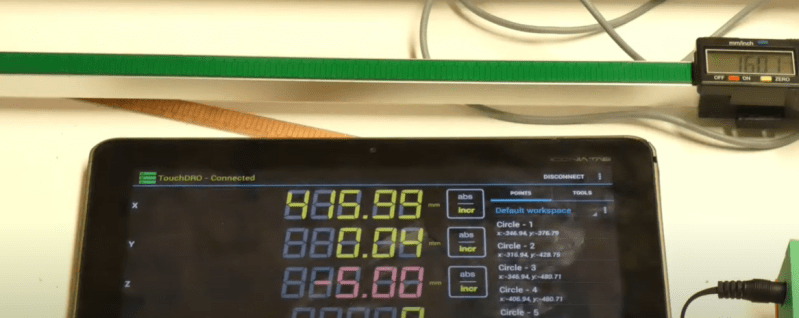The working principle of digital calipers is mysterious enough that we’d never think to dismantle, much less improve them, right? Well, think again, as [Limi DIY] retrofits the processing element onto a custom track, extending the calipers measurement distance to a whopping 650 mm. Combined with a prior project to extract the measurement data, the result makes for a working multi-axis digital readout, a handy device for machine tools like a manual lathe or milling machine.
Digital calipers operate on the principle of measuring an array of variable capacitors. If we scratch our heads and look back at our physics notes, we’ll recall that the capacitance between two parallel conductive plates is linearly proportional to the surface area. By fixing one dimension of both plates and by sliding one plate over the other, we effectively change the area, giving ourselves a simple linear displacement sensor! (There are some classy error-correcting techniques too, and this [PDF] is a great place to look for more details.)
The theory takeaway is that this array of parallel plates can be embedded directly into a printed circuit board. We just need to know the dimensions. After some close measurement work, [Limi DIY] extracted the crucial measurements and fabbed a PCB with the pattern duplicated over 650 mm. After retrofitting the original processing element onto this new track, they had a working measurement device that’s far longer than the original!
If you’ve ever been tempted to disassemble your calipers but too nervous to bite off the investment, now’s your chance to follow along as [Lima DIY] demonstrates the gratuitous disassembly process for you in video format. And the fruits of their labor is also captured on a project post that includes the key dimensions if you’re looking to do the same thing.
If you’re looking for other ways to improve your calipers, why not start by giving them a major battery life boost.
Thanks to [absd] via [Jubilee Discord] for the tip!
















This should give many desktop mills a cheap DRO.
Maybe ten years ago yes, but today inexpensive chinese DRO sets turn this into a waste of time.
Gotta love everyone’s opinion on “cheap”. Plus its china where these things come from. Do you realize you are on hackaday where we do things how one wants and not how someone else thinks?
I’m just imagining this as part of a 3D printer bed or at least along the axis.
There was a project about 10 years ago called Shumatech, run (I recall) by a guy named Scott Shumate, that produced a nice three axis DRO using multiple sets of calipers. I got two and soldered them up but had a lot of issues with noise on the long axis (I got a 24″ calipers for my lathe.) But in general it worked pretty well, and this gets me interested in hooking that back up because I don’t have to cruise ebay trying to find surplus calipers of the right length for my mill’s ways.
The Shumatech version came set up for a nice faceplate-and-button-based interface, although users had to make their own faceplates. I milled one out of FR4 and it worked okay, although it was absolutely not dust or chip proof.
My Shumatech DRO is still working on my mini-mill!
y would use digital tyre depth gauges instead :-) 3 dollars from aliexpress
i not y
Yes, lots of digits. Precision 0.01 mm. Accuracy 1mm. Maybe. Glass quadrature scales with 0.005mm accuracy and resolution, 24 inches, are about 150 USD.
He may have no need for that kind of accuracy. With a crappy run-of-the-mill mill, 0.01mm precision is probably better than the machine can hold anyway. So for a $9.00 caliper (plus effort), he can maybe get his job done. Not a bad bargain.
From what I understand the cheaper calipers use capacitive sensing, but the more expensive ones like mitutoyo use inductive sensing instead as I think its less sensitive to dirt / contamination on the rail.
Same, but the ones using the old Inductosyn patents have become very cheap with a tiny chip under epoxy that does the whole job. The electronic angle measuring devices use it (protractor, compass?). I have not been able to track down the maker of the chip. If I can, I have loads of application ideas. On the other hand, the capacitive must be a lot better for running on watch batteries.
These. I took one apart and recognized the patterns on the PCB. https://www.ebay.com/itm/154534777305
How long can you use it without homing and still have confidence in the measurements?
When used as a caliper you home it then take a measurement and slide it back to zero. So you know before each measurement that it is correctly homed, and there is only about a 5 second period where you need to hope it hasn’t drifted.
In his application this window is being drastically increased. Is it good enough for that?
Did he join two of the PCBs together? It’s hard to tell. If so I wonder how you could possible join them without creating a small error in the measurement.
I was thinking the same. He didn’t even solder them or electrically connect them